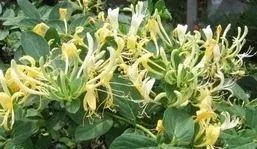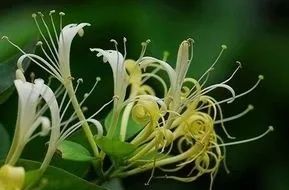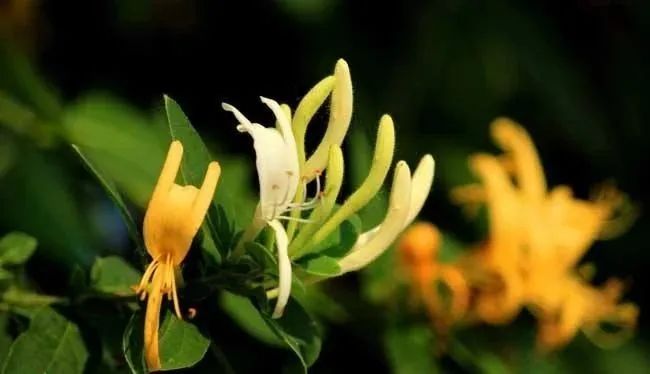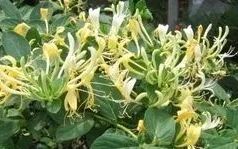Honeysuckle (金银花, Jīn yín huā) is a common medicinal herb, well-known for its infusion, which is often consumed during times of heat-related ailments. However, are you aware that honeysuckle has other significant benefits? Let me explain its extensive uses.
Introduction to Honeysuckle
Honeysuckle, also known as Lonicera japonica (忍冬, Rěn dōng), derives its name from the Compendium of Materia Medica due to its flowers initially blooming white and later turning yellow. The medicinal part of honeysuckle consists of the dried flower buds or the flowers that are just beginning to bloom. Honeysuckle flowers bloom in March, are slightly fragrant, and have a reddish stem. Initially white, the flowers turn yellow after a day or two, hence the name honeysuckle. The flowers grow in pairs, resembling a couple, which is why it is also referred to as ‘Mandarin Duck Vine’ (鸳鸯藤, Yuān yāng téng). This species is characterized by large leaf-like bracts. It resembles the South China honeysuckle but differs in the shape of its bracts and the presence of short soft hairs on the calyx tube. The morphological variations of this species are significant, influenced more by ecological conditions than geographical distribution.

The Efficacy and Functions of Honeysuckle
Honeysuckle has been revered since ancient times as an excellent remedy for clearing heat and detoxifying. It is sweet and cold in nature, aromatic, and can clear heat without harming the stomach, while also dispelling pathogens. Honeysuckle can disperse wind-heat and effectively clear blood toxins, making it useful for various febrile diseases such as fever, rashes, heat toxins, and sore throat.
1. **Anti-inflammatory and Detoxifying Effects**: Honeysuckle has a strong ability to disperse abscesses and reduce swelling, particularly effective for conditions like carbuncles and intestinal abscesses, showcasing significant anti-inflammatory and detoxifying properties.
2. **Dispersing Heat and Evacuating Pathogens**: It is effective for external wind-heat or the initial stages of warm diseases. Symptoms such as fever, headache, irritability, insomnia, and dry throat can benefit from its use.
3. **Sweet and Cold Nature**: Honeysuckle’s sweet and cold nature provides notable heat-clearing and detoxifying effects. It is also effective for treating summer heat syndrome, diarrhea, influenza, and periodontal disease.
4. **Antimicrobial Properties**: Honeysuckle exhibits inhibitory effects against pathogenic microorganisms such as hemolytic streptococcus, Escherichia coli, Vibrio cholerae, and paratyphoid bacteria, showcasing unique properties.
5. **Additional Benefits**: Beyond medicinal uses, honeysuckle has remarkable effects in beauty, weight loss, health maintenance, and longevity, providing significant protection and restorative effects on the body. Its benefits are particularly pronounced for those needing to relieve summer heat, sober up, clear the mind, quench thirst, detoxify, lower lipids, lose weight, prevent aging, and promote longevity.

Methods of Using Honeysuckle
Honeysuckle tea can treat summer heat syndrome, diarrhea, influenza, carbuncles, acute and chronic tonsillitis, and periodontal disease.
Fresh honeysuckle has a pleasant fragrance and high moisture content, often enjoyed by rural children who suck the nectar from the flowers. The fresh flower stems can be dried or processed like green tea to make honeysuckle tea.
There are several types of honeysuckle tea:
1. **Honeysuckle and Dandelion Tea** (金蒲菊茶, Jīn pú jú chá) – for clearing heat and reducing inflammation, and for liver detoxification.
Preparation: Combine 2.2g of dandelion, 0.5g of chrysanthemum, and 0.3g of honeysuckle into a small tea bag and drink daily.
Indications: Clears heat, reduces inflammation, promotes liver detoxification.
Dandelion is slightly bitter yet sweet and cold, effectively clearing heat and detoxifying without harming the stomach. The combination of dandelion and honeysuckle provides dual effects of heat-clearing, detoxifying, and antibacterial properties. Dandelion can counteract liver cell damage caused by endotoxins, alleviating toxicity and protecting the liver.
Chrysanthemum protects liver cells by scavenging free radicals and inhibiting lipid peroxidation, specifically reducing serum alanine aminotransferase and aspartate aminotransferase levels, thereby alleviating liver cell damage.

2. **Three Flower Tea** (三花茶, Sān huā chá)
Preparation: Combine 10g of honeysuckle, 10g of chrysanthemum, and 3g of jasmine, and steep in boiling water to drink.
Indications: Clears heat and detoxifies, treats headache, thirst, and sore throat.
Jasmine tea helps clear the liver, brighten the eyes, generate fluids, quench thirst, relieve phlegm, promote urination, and dispel wind. It also aids in weight loss, but those prone to tea intoxication or with emotional sensitivity should limit consumption, especially in the evening.
3. **Honeysuckle Congee** (金银花粥, Jīn yín huā zhōu)
Preparation: Add a small amount of honeysuckle buds while cooking congee. Indications: Boosts immunity.
4. **Honeysuckle and Peach Blossom Drink** (金银桃花饮, Jīn yín táo huā yǐn)
Preparation: Boil 15 peach blossoms and 10g of honeysuckle in water. Indications: Treats dysentery.
Peach blossoms contain nutrients such as amygdalin, aromatic compounds, and vitamins A, B, and C, which can dilate blood vessels, improve circulation, and nourish the skin.

Precautions for Drinking Honeysuckle Water
1. Do not consume in excess;
2. Not suitable for women during menstruation;
3. Use with caution for those with spleen and stomach deficiency or hepatitis B;
4. Do not drink overnight.

